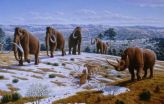(Press-News.org) A team made up of members of the University of Oviedo (UO) and the Complutense University of Madrid (UCM) have gathered together all findings of the woolly mammoth, the woolly rhinoceros and the reindeer in the Iberian Peninsula to show that, although in small numbers, these big mammals, prehistoric indicators of cold climates, already lived in this territory some 150,000 years ago.
The presence of the woolly mammoth (Mammuthus primigenius), the woolly rhinoceros (Coelodonta antiquitatis), the reindeer (Rangifer tarandus), and to a lesser extent the wolverine (Gulo gulo), the arctic fox (Alopex lagopus), the musk-ox (Ovibos moschatus) and the Saiga antelope (Saiga tatarica), has been linked to the paleoclimatic scale created on the basis of the isotopic composition of oxygen in the ice of Greenland.
"The findings of cold climate fauna in the Iberian Peninsula coincide with the periods of greatest global cooling recorded in the ice of Greenland", Diego Álvarez-Lao, main author of the work and researcher in the Palaeontology Department of the UO explains to SINC.
The study, which has been published in the journal Quaternary International, reveals that the oldest remains of mammals adapted to cold climates found in the Iberian Peninsula belong to great prehistoric mammals which lived isolated in Spain 150,000 years ago.
The "glacial fauna" entered the Peninsula at that time because "the environmental conditions in central and northern Europe were so extreme that the animals were obliged to migrate to the south, where the climate was less severe", Álvarez-Lao explains.
44,000 years ago these animals became more common in the Iberian Peninsula but only for periods. "The cold periods (with the presence of glacial fauna) alternated with milder periods", adds the researcher.
The increase in temperatures caused a biological crisis
According to the team, the last findings of these cold species date back some 10,000 years, and coincide with the end of the glaciations. At that time, the climate became warmer in the whole northern hemisphere and the favourable habitat for these faunae was reduced to increasingly more northern latitudes and to smaller spaces.
"The increase in temperatures caused a genuine biological crisis for these animals from extremely cold climates. Some species such as the reindeer and the arctic fox found their new habitat in the arctic regions of the planet, where they still survive today. Others, such as the woolly mammoth and the woolly rhinoceros weren't so lucky", specifies the paleontologist.
According to the studies of pollen remains associated with these findings, the landscape of the period in which the great mammals lived in the Iberian Peninsula comprised mainly of steppes, or herbaceous vegetation. "Trees would have been very scarce in these times of extreme cold and environmental aridity", Álvarez-Lao points out.
More than 72 sites with remains of mammals
The Spanish researchers found the fossil remains of glacial climate fauna in 72 Iberian sites, the majority of which are in the north of the peninsula (Cornisa Cantabrica and Catalonia). There are also some traces in inland areas of the peninsula and even in the south, where the site of the woolly mammoths of Padul (Granada) lies.
"These species lived alongside different human cultures. There is evidence in some sites of the Basque country, Navarra and Catalonia that the Neanderthals coexisted with the mammoths and the reindeer at specific times. However, the majority of evidence of these faunae coincides with the periods of the Gravettian, Solutrean and Magdalenian cultures (during the Upper Paleolithic era in West Europe)", states Álvarez-Lao.
INFORMATION:
References:
Álvarez-Lao, Diego J.; García, Nuria. "Chronological distribution of Pleistocene cold-adapted large mammal faunas in the Iberian Peninsula" Quaternary International 212(2): 120-128, 2010.
The reindeer and the mammoth already lived on the Iberian Peninsula 150,000 years ago
2010-09-07
ELSE PRESS RELEASES FROM THIS DATE:
Scientists develop device to enable improved global data transmission
2010-09-07
Researchers have developed a new data transmission system that could substantially improve the transmission capacity and energy efficiency of the world's optical communication networks.
Transmission of data through optical networks is currently limited by 'phase noise' from optical amplifiers and 'cross talk' induced by interaction of the signal with the many other signals (each at a different wavelength) simultaneously circulating through the network. 'Phase noise' is the rapid, short-term, random fluctuations in the phase of a signal, which affects the quality of the ...
Bipolar disorder does not increase risk of violent crime
2010-09-07
A new study from Sweden's Karolinska Institutet suggests that bipolar disorder – or manic-depressive disorder – does not increase the risk of committing violent crime. Instead, the over-representation of individuals with bipolar disorder in violent crime statistics is almost entirely attributable to concurrent substance abuse.
The public debate on violent crime usually assumes that violence in the mentally ill is a direct result of the perpetrator's illness. Previous research has also suggested that patients with bipolar disorder – also known as manic-depressive disorder ...
Fox Chase researchers uncover activation signal for Aurora-A oncogene
2010-09-07
PHILADELPHIA, PA. (September 7, 2010)—Aurora-A kinase (AurA) is an enzyme that is hyperactive in many cancers and drives tumor cell proliferation. Several AurA inhibitors are currently being tested in clinical trials to see if they slow tumor growth. Now, researchers in the Developmental Therapeutics Program at Fox Chase Cancer Center have identified an activation signal for AurA. They report in the September 7 issue of Nature Communications that a quick increase in the calcium concentration in a cell rapidly triggers AurA kinase activity. The discovery may lead to drug ...
New method for infrared remote sensing to analyze traffic pollution
2010-09-07
The methodology, which has been used in this research in collaboration with the Universidad Europea de Madrid, is based on the Open-Path FTIR technique which takes advantage of specific properties of gases in order to detect them: they absorb radiation only in certain wave lengths which are always the same and particular to each gas. Many gases have absorption lines or bands in the infrared, for which this area of the electromagnetic spectrum is very useful for the remote detection of gases, according to the authors of this research from the UC3M Department of Physics. ...
First Irish genome sequenced
2010-09-07
The first entire genome of an Irish individual has been sequenced. The sequence is reported in BioMed Central's open access journal, Genome Biology and provides insight into the evolutionary history of this distinct lineage.
Led by Professor Brendan Loftus, the research team from UCD Conway Institute used data from a previous genotyping study to select a suitable Irish male representative for sequencing. Then, using pair- and single-ended Illumina short read sequencing, one of the next generation sequencing approaches, the team created 9 DNA sequence libraries, which ...
GOCE gravity mission back in action
2010-09-07
ESA's GOCE gravity mission has recovered from a glitch that prevented the satellite from sending its flow of scientific data to the ground. News of the recovery comes earlier than expected, thanks to the fervent efforts of a team of experts.
The recovery follows a serious communications malfunction on 8 July, when the Gravity field and steady-state Ocean Circulation Explorer (GOCE) satellite suddenly failed to downlink scientific data to its receiving stations.
Extensive investigations by experts from ESA and industry revealed that the issue was almost certainly related ...
What can a New Zealand reptile tell us about false teeth?
2010-09-07
Using a moving 3D computer model based on the skull and teeth of a New Zealand reptile called tuatara, a BBSRC-funded team from the University of Hull, University College London and the Hull York Medical School has revealed how damage to dental implants and jaw joints may be prevented by sophisticated interplay between our jaws, muscles and brain. This research will appear in a future edition of the Journal of Biomechanics.
The tuatara is a lizard-like reptile that has iconic status in its homeland of New Zealand because its ancestors were widespread at the time of the ...
Is hand washing enough to stop the spread of disease?
2010-09-07
Not drying your hands thoroughly after washing them, could increase the spread of bacteria and rubbing your hands whilst using a conventional electric hand dryer could be a contributing factor. Frequently people give up drying their hands and wipe them on their clothes instead, but hand-hygiene is a key part of infection control and drying hands after washing is a very important part of the process.
A study by researchers at the University of Bradford and published today in the Journal of Applied Microbiology looked at different methods of hand drying, and their effect ...
Unrelated kidney donor study shows age and obesity increase complications
2010-09-07
Patients who have received a new kidney are significantly more likely to develop transplant renal artery stenosis (TRAS) if they are obese or over 50, according to research published in the September issue of the Journal of Renal Care.
Researchers from Iran studied 360 recipients who had received kidneys from unrelated donors to discover what factors increased the risk of TRAS, where the renal arteries narrow, impeding blood flow to the kidney.
They found that having had a previous transplant, elevated triglyceride (fatty molecule) levels, cytomegalovirus (CMV) infection ...
Multivitamin use doesn't impact colon cancer outcomes
2010-09-07
BOSTON--Patients with colon cancer who used multivitamins during and after being treated with post-surgical chemotherapy did not reduce the risk of the cancer returning or their dying from it, according to researchers at Dana-Farber Cancer Institute.
In a study of patients with stage III colon cancer – characterized as cancer in the large bowel area with some cancer cells in a few nearby lymph nodes -- the researchers found that while multivitamin use had no beneficial effect on patients' outcomes, it also did not have a detrimental effect. The findings are reported online ...


